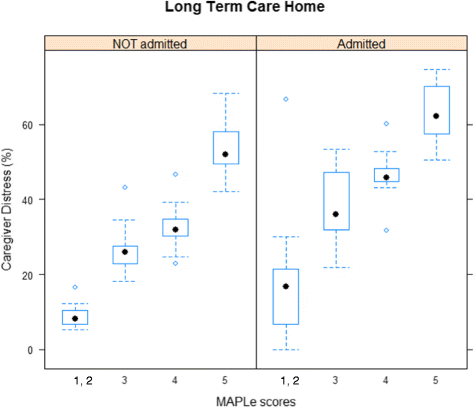A longitudinal study looking at and beyond care recipient health as a predictor of long term care home admission
- PMID: 29121916
- PMCID: PMC5680746
- DOI: 10.1186/s12913-017-2671-8
A longitudinal study looking at and beyond care recipient health as a predictor of long term care home admission
Abstract
Background: The unpaid care provided by informal caregivers allows care recipients to live longer in their homes, which often results in fewer unnecessary long term care home (LTCH) admissions. Although the relationship between care recipient's health characteristics and institutionalization is well known, the influence of caregiver distress and caregiving coresidence and relationship on this outcome is less clear. This study examines the association of care recipient care needs, caregiver distress and caregiving coresidence and relationship with care recipient long term care home admission.
Methods: A total of 94,957 resident assessment instruments-home care (RAI-HC), completed between April 01st 2013 and April 01st, 2014 as part of a clinical practice by 14 Local Health Integration Networks (LHINs) in Ontario, Canada, were linked to LTCH admissions within 1 year after completion of the first RAI-HC assessment. Cox models were used to examine whether care recipient health care needs, caregiver distress and caregiving characteristics such as coresidence and relationship were associated with LTCH admission. Age, marital status and gender of the care recipient were included as covariates in the model.
Results: Care recipient health care needs and age were the strongest predictors of LTCH admission followed by caregiver distress and caregiving coresidence and relationship. Care recipient marital status was not significant in the survival model. Interestingly, care recipients who were cared for by a coresiding adult child caregiver were less likely to be admitted to a LTCH than care recipients cared for by a spouse caregiver coresiding or not with care recipient. Hazard rates (HR) of admission for care recipients cared for by caregivers coresiding and with other type of relationship with care recipient were not significantly different than HR of care recipients cared for by coresiding child caregivers.
Conclusions: These results emphasize the influence of caregiver distress in LTCH admission and highlight the impact of caregiving relationship and coresidence on this outcome. Policy and decision makers should consider these findings when developing and evaluating interventions aiming to avoid LTCH admissions. Moreover, caregiving coresidence and relationship should be explored in future studies with similar aims, as this information has been neglected in past research.
Keywords: Carer; Coresidence; Distress; Relationship; interRAI.
Conflict of interest statement
Ethics approval and consent to participate
Ethics clearance for the use of secondary data has been provided by the Office of Research ethics from University of Waterloo (ORE#1822). This study did not require a consent to participate.
Consent for publication
Not applicable.
Competing interests
The authors declare that they have no competing interests.
Publisher’s Note
Springer Nature remains neutral with regard to jurisdictional claims in published maps and institutional affiliations.
Figures

Similar articles
-
Development and validation of a screener based on interRAI assessments to measure informal caregiver wellbeing in the community.BMC Geriatr. 2018 Dec 13;18(1):310. doi: 10.1186/s12877-018-0986-x. BMC Geriatr. 2018. PMID: 30545318 Free PMC article.
-
Effects of home-based long-term care services on caregiver health according to age.Health Qual Life Outcomes. 2017 Oct 23;15(1):208. doi: 10.1186/s12955-017-0786-6. Health Qual Life Outcomes. 2017. PMID: 29061145 Free PMC article.
-
Gender differences in home care clients and admission to long-term care in Ontario, Canada: a population-based retrospective cohort study.BMC Geriatr. 2013 May 16;13:48. doi: 10.1186/1471-2318-13-48. BMC Geriatr. 2013. PMID: 23678949 Free PMC article.
-
Association of Informal Caregiver Distress with Health Outcomes of Community-Dwelling Dementia Care Recipients: A Systematic Review.J Am Geriatr Soc. 2019 Mar;67(3):609-617. doi: 10.1111/jgs.15690. Epub 2018 Dec 10. J Am Geriatr Soc. 2019. PMID: 30536383
-
Caregiver burden among dementia patient caregivers: a review of the literature.J Am Acad Nurse Pract. 2008 Aug;20(8):423-8. doi: 10.1111/j.1745-7599.2008.00342.x. J Am Acad Nurse Pract. 2008. PMID: 18786017 Review.
Cited by
-
Family Physician's and Primary Care Team's Perspectives on Supporting Family Caregivers in Primary Care Networks.Int J Environ Res Public Health. 2021 Mar 23;18(6):3293. doi: 10.3390/ijerph18063293. Int J Environ Res Public Health. 2021. PMID: 33806725 Free PMC article.
-
Creating opportunities to improve detection of older adult abuse: a national interRAI study.BMC Geriatr. 2022 Mar 17;22(1):220. doi: 10.1186/s12877-022-02938-3. BMC Geriatr. 2022. PMID: 35300608 Free PMC article.
-
Derivation and validation of an algorithm to predict transitions from community to residential long-term care among persons with dementia-A retrospective cohort study.PLOS Digit Health. 2024 Oct 18;3(10):e0000441. doi: 10.1371/journal.pdig.0000441. eCollection 2024 Oct. PLOS Digit Health. 2024. PMID: 39423179 Free PMC article.
-
Sociodemographic Factors and Characteristics of Caregivers as Determinants of Skilled Nursing Facility Admissions When Modeled Jointly With Functional Limitations.J Am Med Dir Assoc. 2019 Dec;20(12):1599-1604.e4. doi: 10.1016/j.jamda.2019.01.154. Epub 2019 Mar 20. J Am Med Dir Assoc. 2019. PMID: 30902676 Free PMC article.
-
What matters to people aged 80 and over regarding ambulatory care? A systematic review and meta-synthesis of qualitative studies.Eur J Ageing. 2021 Aug 21;19(3):325-339. doi: 10.1007/s10433-021-00633-7. eCollection 2022 Sep. Eur J Ageing. 2021. PMID: 36052193 Free PMC article. Review.
References
-
- Hollander MJ, Liu G, Chappell NL. Who cares and how much? The imputed economic contribution to the Canadian healthcare system of middle-aged and older unpaid caregivers providing care to the elderly. Law Gov. 2009;12:42–49. - PubMed
-
- Turner A, Findlay L. Informal caregiving for seniors. Health Rep. 2012;23:33–36. - PubMed
-
- Lazarus R, Folkman S. Stress, appraisal, and coping. New York: Springer publishing company; 1984.
MeSH terms
LinkOut - more resources
Full Text Sources
Other Literature Sources
Medical
Miscellaneous

